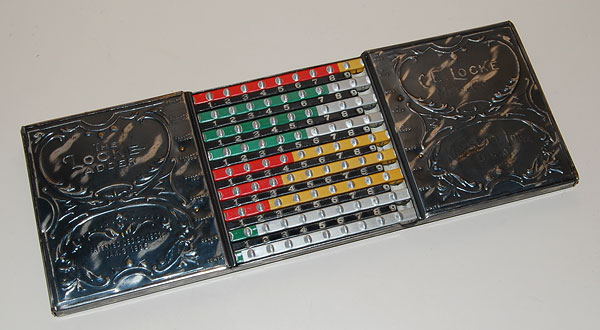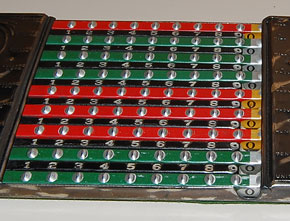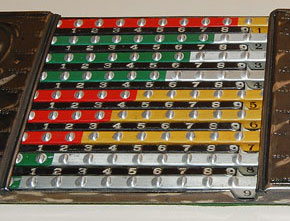 |
|
|
|

|

|
Locke's "pocket" adder |
|
|
|
|
Two things strike you when you see the Locke adder: its beauty, and its limited utility. The beauty is indisputable: it’s as colorful and decorative as the peacock’s tail. The low utility was not what Mr. Locke had in mind: the instructions booklet extols his creation with phrases like “Fastest, Simplest, Handiest, Most practical and durable, Low priced, Calculating Machine” and “Enthusiastic users everywhere endorse it”. But then, he also says “The adder will slip into the pocket for carrying from place to place”; and given its 27 x 10 cm size, that would require a pretty deep pocket... |
|
|
|
 Click photo to enlarge |
|
|
|
The Locke adder is a nine digit slide adder. As usual in those days, it was touted as a four function machine, although multiplication and division require you to do much of the intermediate action in your head, then add or subtract the partial results on the adder. You add numbers by placing your fingertip beyond the bump on a sliding bar next to the desired digit on the stationary scale, and sliding the bar to the left until your finger is stopped by the plate at the left. This will increment the output readout, visible in a notch at the right, by the digit you entered. Or it will, anyway, if you wouldn’t exceed 9 in the result; otherwise you need to carry one to the next decimal place, which in the Locke adder is done manually -- you move the current bar in reverse and slide the next bar one stop forward, using both hands at once. |
|
|
|

 Click a photo to enlarge Left: all bars set to zero; Right: bars set to read 123,456,789 |
|
|
|
In all fairness, Locke color coded the bars
to make it easy to know in advance when this is about to happen; and
the instructions put much weight on practice, which could give one
some proficiency in rapidly manipulating the bars. Still, this
device is from the early 20th century, when much more advanced
machines were becoming available. Compare the Locke to the
contemporaneous Gem adder, which not only
did automatic carry but was also truly pocketable, and you can only
regard it as a quaint atavism. The Locke was made by the C. E. Locke Mfg. Co., Kensett, Iowa, and bears patent dates from 1901 and 1905. It had a very upbeat manual, which concluded with the observation: “The Adder is the acme of simplicity, having no delicate mechanism to get out of order, or be deranged by dust, wear or accident... No attention whatever is needed to keep it in working order”. And indeed that is borne out by observation: mine works smoothly a century after its manufacture. |
|
|
|
Exhibit provenance: Got this from an antiques dealer in the USA. More info: |
|
|
|
|
|
|
|
Home | HOC | Fractals | Miscellany | About | Contact Copyright © 2008 N. Zeldes. All rights reserved. |
|